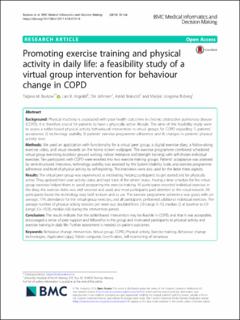| dc.contributor.author | Burkow, Tatjana M. | |
| dc.contributor.author | Vognild, Lars Kristian | |
| dc.contributor.author | Johnsen, Elin | |
| dc.contributor.author | Bratvold, Astrid | |
| dc.contributor.author | Risberg, Marijke Jongsma | |
| dc.date.accessioned | 2023-07-06T07:41:50Z | |
| dc.date.available | 2023-07-06T07:41:50Z | |
| dc.date.created | 2019-02-18T17:19:36Z | |
| dc.date.issued | 2018 | |
| dc.identifier.citation | BMC Medical Informatics and Decision Making. 2018, 18 (136), 1-13. | en_US |
| dc.identifier.issn | 1472-6947 | |
| dc.identifier.uri | https://hdl.handle.net/11250/3076453 | |
| dc.description.abstract | Background
Physical inactivity is associated with poor health outcomes in chronic obstructive pulmonary disease (COPD). It is therefore crucial for patients to have a physically active lifestyle. The aims of this feasibility study were to assess a tablet-based physical activity behavioural intervention in virtual groups for COPD regarding 1) patients’ acceptance 2) technology usability 3) patients’ exercise programme adherence and 4) changes in patients’ physical activity level.
Methods
We used an application with functionality for a virtual peer group, a digital exercise diary, a follow-along exercise video, and visual rewards on the home screen wallpaper. The exercise programme combined scheduled virtual group exercising (outdoor ground walking, indoor resistance and strength training) with self-chosen individual exercises. Ten participants with COPD were enrolled into two exercise training groups. Patients’ acceptance was assessed by semi-structured interviews, technology usability was assessed by the System Usability Scale, and exercise programme adherence and level of physical activity by self-reporting. The interviews were also used for the latter three aspects.
Results
The virtual peer group was experienced as motivating, helping participants to get started and be physically active. They updated their own activity status and kept track of the others’ status. Having a time schedule for the virtual group exercises helped them to avoid postponing the exercise training. All participants recorded individual exercises in the diary, the exercise video was well received and used, and most participants paid attention to the visual rewards. All participants found the technology easy both to learn and to use. The exercise programme adherence was good, with, on average, 77% attendance for the virtual group exercises, and all participants performed additional individual exercises. The average number of physical activity sessions per week was doubled from 2.9 (range 0–10, median 2) at baseline to 5.9 (range 3.3–10.33, median 4.8) during the intervention period.
Conclusion
The results indicate that the tablet-based intervention may be feasible in COPD, and that it was acceptable, encouraged a sense of peer support and fellowship in the group and motivated participants to physical activity and exercise training in daily life. Further assessment is needed on patient outcomes. | en_US |
| dc.language.iso | eng | en_US |
| dc.rights | Navngivelse 4.0 Internasjonal | * |
| dc.rights.uri | http://creativecommons.org/licenses/by/4.0/deed.no | * |
| dc.title | Promoting exercise training and physical activity in daily life: a feasibility study of a virtual group intervention for behaviour change in COPD | en_US |
| dc.title.alternative | Promoting exercise training and physical activity in daily life: a feasibility study of a virtual group intervention for behaviour change in COPD | en_US |
| dc.type | Peer reviewed | en_US |
| dc.type | Journal article | en_US |
| dc.rights.holder | © The Author(s). 2018 | en_US |
| dc.description.version | publishedVersion | en_US |
| cristin.ispublished | true | |
| cristin.fulltext | original | |
| cristin.qualitycode | 1 | |
| dc.identifier.doi | 10.1186/s12911-018-0721-8 | |
| dc.identifier.cristin | 1678501 | |
| dc.source.journal | BMC Medical Informatics and Decision Making | en_US |
| dc.source.volume | 18 | en_US |
| dc.source.issue | 136 | en_US |
| dc.source.pagenumber | 1-13 | en_US |

